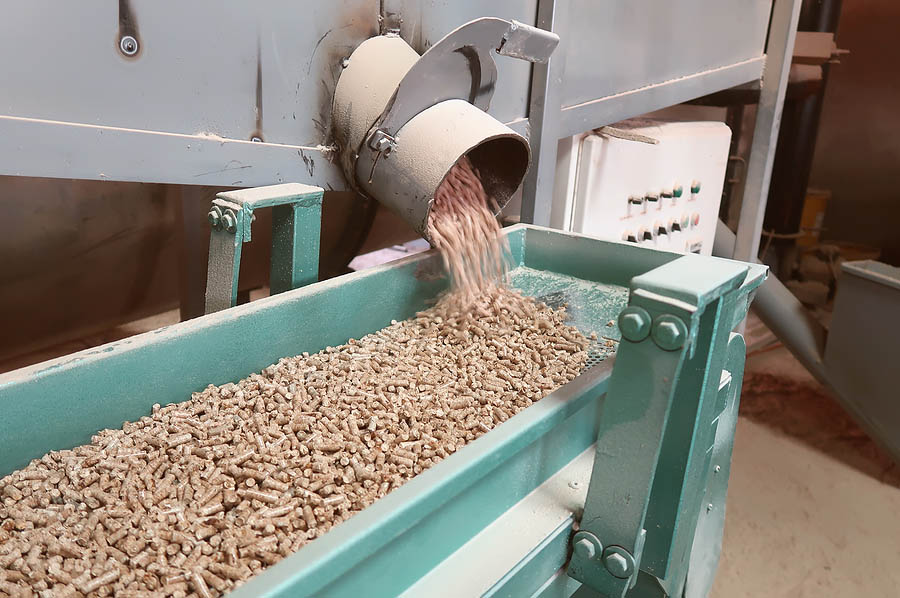As more countries, businesses, and private individuals recognize the need to do their part to reduce their carbon footprint and counteract global climate change, they seek alternative fuel sources for heating, cooking, and energy production. The surprising outcome of this search for more environmentally friendly fuels is that several of these options are also less expensive than the fossil fuels they are replacing. This is certainly true of wood fuel pellets made from sawdust. As oil prices continue to rise, alternatives to oil and propane fuels are becoming more sought after, and what better fuel source than a material that would otherwise end up in landfills?
Wood pellets are made from sawdust produced by grinding down wooden pallets at the end of their useful life cycle. Pallets can be reused, repaired, and remanufactured until the component lumber is no longer structurally sound, at which point they can be reduced to wood chips or sawdust and sold in bulk for new uses, including the production of wood fuel pellets. No chemically treated pallets are used in the manufacture of this sawdust – in fact, heat treatment of lumber as a preventive measure against parasites has generally replaced the use of chemical pesticide treatments in the United States and Canada. International pallets are clearly marked with the type of preventive treatment used, making it easy to identify and discard any lumber that was chemically treated.
For customers considering the switch to wood pellets for heating or energy production, the obvious question is how efficient are wood pellets in comparison to traditional fuels? Due to their low moisture content (properly made wood pellets contain less than 8 percent moisture), they are among the most clean burning and efficient fuels available. Wood pellets burn with very little ash due to their low water content, burning at about 95 percent combustion, and they release less carbon than would have been produced through the natural decomposition of the lumber that went into them. The heat they produce is approximately 8,000 to 9,000 BTU/lb, making them a highly efficient heat source for domestic and commercial use.
Making wood pellets from sawdust requires some dedicated machinery, but the process itself is fairly straightforward.
Moisture Content.
Your sawdust may need to be dried before it is ready for compression into pellets. An acceptable moisture content for pellet production is between 10-15 percent, with 12-14 percent being optimal. If your sawdust is too dry, a light mist of water may be needed to rehydrate it enough for the pellets to hold together.
Screening and Sifting.
This step removes any impurities or foreign particles that may interfere with the operation of the pellet mill. Magnets can be used to remove any metallic debris, while stone, plastic, or other foreign matter can be sifted or screened out. While a version of this process has already taken place during the sawdust production process, it’s wise to ensure that no small particles had been missed and nothing new has since been introduced, for the safety of your equipment.
Pellet Making.
Allow the pellet machine to prime and heat, and then feed sawdust into the hopper gradually and consistently, either by hand or shovel, or using a screw feeder for larger scale operations.
Cooling and Setting.
When the pellets first emerge from the mill, they are too hot for packing, handling, or immediate use. Allow them to set in a pellet cooler that will maintain a stable humidity and prevent the introduction of excess moisture.
Sieve the Pellets.
Use of a vibrating sieve will separate out any sawdust or broken pellets that failed to form properly; this material can be returned to the hopper for reuse, while the intact pellets are ready for packing and storage.
Pack and Store.
A packing machine makes it easy to bag the pellets for storage in a dry environment, off the ground and out of direct sunlight. Adding a tarp provides additional protection against moisture and UV light which can degrade the packaging.
The push for greener and more carbon-conscious energy production is only growing stronger with time, and many governments and municipalities are offering subsidies and financial incentives for more ecologically responsible fuel alternatives. The use of sawdust, a waste product from the end-of-life stages of wood shipping pallets, as a fuel source is more cost-effective than petroleum fuels. Burning wood pellets made from ground pallets releases less carbon than allowing the wood to rot. In addition, every stage of the life cycle of the fuel – from lumber production to the wood pallet industry to recycling into sawdust and manufacture into wood pellets – takes place domestically, reducing reliance on overseas fossil fuels and supporting American industry. Converting to using wood pellet fuel and producing your own pellets from sawdust, for internal use or commercially, is a sound investment.
Greenway Products & Services is here to satisfy any of your sawdust needs; contact us with any questions you may have, and for a quote.




Leave A Comment